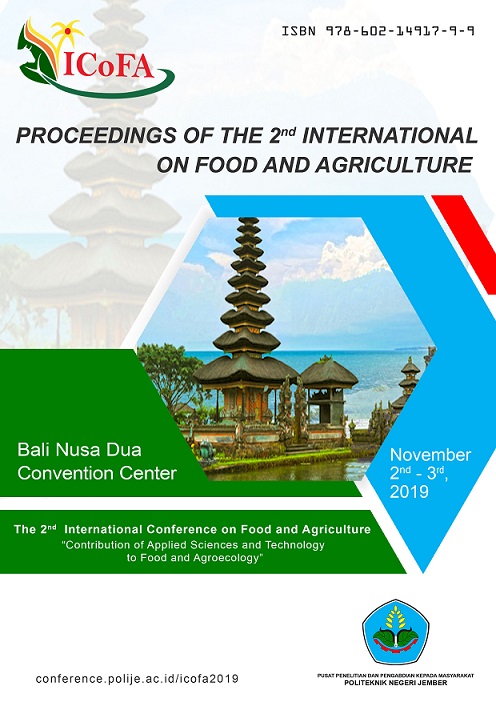SUSTAINABILITY ANALYSIS OF INTEGRATED FARMING BUSINESS MODELS OF FOOD CROP AND BEEF CATTLE
Abstract
Generally, beef cattle and food crop business are still being diversified and have not implemented yet in integrated farming. From those reason above, we need a model of integration of beef cattle and crop Systems (SISPOTTA), namely farming systems that was integrate between beef cattle business with crops as an effort to develop sustainable livestock, especially for areas with irrigation fields. Purpose of this research was to analyze the sustainability status of economic dimension, ecology, technology, social and institution of the integrated system of cattle business and crop farming in irrigation fields. Determination location of this research was carried out based on the Multistage Sampling Method, each location was carried out by Purpose Sampling. Jember district was chosen as the location of this research, because from the previous survey information showed that Jember district had a rice field area used a technical irrigation system so those field can applied a cropping pattern model within one year with rice plants and other food crops such as corn, and soybeans. Besides, farmers are accustomed to raising cattle, especially beef cattle additional activities besides crop farming. This research conducted from November 2016 to April 2017. Sustainability Analysis with MDS Rap-Sispotta as the data Analysis of this research. Based on the five existing dimensions, the results showed that the agribusiness integration system of cattle and crops in this research area has a sustainability index value of 42.40. This index showed that agribusiness is still less sustainable. The dimensions that have the worst sustainability index and need to be taken seriously at are technology and infrastructure dimensions, also law and institutional dimensions.References
Budianto, J. 2006. Kebijakan Penelitian dan Pengembangan Teknologi Peningkatan Produktivitas Padi Terpadu di Indonesia. Disampaikan pada Lokakarya Peningkatan Program Produktivitas Produktivitas Padi Terpadu 2002 Jogjakarta, 17 – 18 Desember 2003.
Kapa and Maximilian M J 2006. Produktivitas Usaha tani dalam Sistem PertanianTerpadu: StudiKasus di Kecamatan Amarasi Kabupaten Kupang, Nusa Tenggara Timur. Proceedings of a Workshop to Identify Sustainable Rural Livelihoods, Held in Kupang, Indonesia, 5–7 April (ACIAR Proceedings No. 126).
Devendra, C. 1993. Sustainable Animal Production from Small Farm Systems in South East Asia.Food and Agriculture Organization Animal Production and Health Paper. Food and Agriculture Organization, Rome.
Pitcher T J 1999 FAO Fisheries Circular No. FIRM/C: 947 47
Foot A.S., Banes S, Oge J A C G, Howkins J, Nielsen V C and Callaghan J R O 2006. Studies on Farm Livestock Waste. 1st ed. Agriculture Research Council, England.
Ranaweera N, Dixon J N and Jodha N S 1999 Journal of the Asian Farming Systems Association 2 1-15.
Pitcher T J and Preikshot D B 2001 Fisheries Research 49(3): 255-270.
Kavanagh P. and Pitcher T J 2004 Fisheries Centre Research Reports 12 2.
Ranaweera, N., J.M. Dixon and N.S. Jodha. 1993. Sustainability and Agricultural Development: A Farming System Perspective. Journal of the Asian Farming Systems Association, 2(1): 1-15

